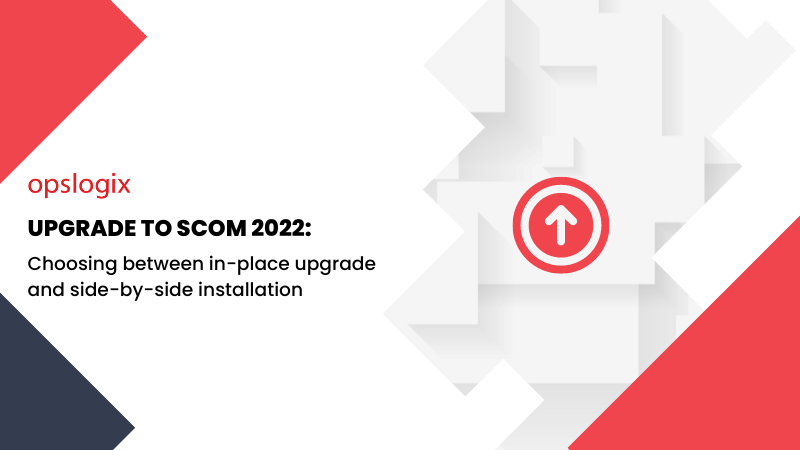Upgrade to SCOM 2022: In-place upgrade or side-by-side installation
by Jonas Lenntun, on Feb 29, 2024 1:33:12 PM

With mainstream support for SCOM 2019 ending on the 9th of April 2024, it is time to start planning for the upgrade to SCOM 2022.
However, there are several factors to consider before making an upgrade. One of them is whether you should choose an in-place upgrade or a side-by-side installation.
In this blog post, we aim to give you some important aspects to evaluate when making your decision.
Key questions to asses
It is time to upgrade your Operations Manager environment, and you need to consider whether you should upgrade your existing installation, or build a new environment side-by-side.
Start out by asking yourselves these questions:
- Did you previously upgrade your current installation?
If you have, we would recommend considering a new installation. Several changes might have been made over the years, which would likely make it less complicated to start fresh. - What SCOM version are you currently running?
Upgrading the individual components one by one is recommended for the most efficient and seamless upgrade. When considering what approach to take, it also includes life cycle management of all components in the installation, such as the Operating System and SQL Server. If you were to upgrade everything at once it could mean downtime and extra work along the way. - How is your SCOM environment working today?
If you experience issues with performance, such as unusual errors, it could be the result of obsolete Management Packs or a misbehaving SCOM configuration. When this is the case, it is a good indication that you should start over again. - Do you keep thorough documentation and follow strict naming conventions?
When working with SCOM, keeping the structure is essential. As you may have had different people working with it throughout the years, they might have used different naming conventions when it comes to overrides and groups. Because of this, we recommend cleaning up your existing environment or that you carry out a new strict naming convention. - Are your current monitoring needs reflected in the present environment?
Requirements can change over time, and what was relevant when your current environment was installed may have changed since then. When making an upgrade, you get the opportunity to review the requirements and see if anything should be altered.
There are also pros and cons with the two options to be considered, some of which are listed below.
Side-by-side installation
Pros
- You get to start fresh and can get rid of old errors or incorrect configurations.
- Avoid a big bang upgrade while making the transition to the new installation.
- Use the latest Operating System and SQL Server supported by SCOM.
- Be able to test integrations in a controlled environment before going live.
- A lower impact on the performance of Management Packs and workloads, and the ability to monitor them along the way as they are implemented.
Cons
- Data Warehouse history from the old database will be lost.
- You will need to redirect consoles for clients.
- Firewall rules and backups need to be verified or reconfigured.
- There will be additional work needed for multi-homing agents, which adds some complexity with Linux Agents.
- Because of the new Management Group Name, you need new licenses for third-party software.
- Reconfiguration of all configuration files and registry settings is necessary.
In-place upgrade
Pros
- Firewall rules and backups will keep working.
- Management Packs are already installed and configured.
- Implementing a new version is quicker.
- The ability to retain Data Warehouse history.
- Agents do not have to be multihomed.
Cons
- The upgrade is complex, and there is an increased risk of errors occurring.
- If you run SCOM on older versions of the Operating System and SQL Server, attention to this is required before the actual upgrade, which brings additional complexity and risk.
- The preparations and upgrade require more downtime.
- Current errors will remain in your database.
- Current performance issues will be brought into the upgraded version.
Upgrade to SCOM 2022 with Opslogix
Upgrading your environment to SCOM 2022 can be complex, and it can be useful to have expert support along the way.
At Opslogix, we are specialists in SCOM. Throughout the years, our team has established a best practice method of upgrading, which has been applied to a wide number of organizations in various sectors globally.
Discuss your upgrade to SCOM 2022 by contacting us through the buttons below.




